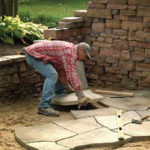Late season projects

I received a phone call recently that I was not expecting quite yet. They wanted to know if was going to push snow for them again this year. Ouch! Where has this year gone? Didn’t we just have a hot and humid week in the 90’s? I was out on the lake swimming! We still have eight more weeks. Wait a minute, eight weeks? Ouch again!
Many contractors run the clock out towards the end of the season, trying to get as much done as possible before the snow flies. Some years it pays off, some years - not so much. While the brick could care less how cold it is, a lot of your accessories might. So if you are going to place that bet this year, let me give you some insider information to help increase your odds.

The paver adhesive that we sell at our Hardscape store can be used on a wet surface, as well as when it's below freezing. Keep in mind that it will take longer to fully dry and cure. Be careful not to have too much water on the surface, such as puddles on the pieces you are gluing. The water will freeze and expand, leaving a gap that more water can enter and repeat this process. If this occurs, your wall will have a nice wavy appearance, and will guarantee you a future failure.
Polymeric sweeping sands have advanced over the years, making them easier to use with less hazing concerns. But they still need time to dry. The colder the weather, the longer the dry time will be. If you choose not to install sand in your joints, you may want to cover the area with a tarp for the winter. This will prevent water and snow from entering and freezing inside the exposed unfilled joints.

Sealers also need time to dry, but are pickier about temperature. It was once recommended to let a patio set for a year before applying sealer.
The idea was to let the efflorescent salts work their way out of the brick, and not having them become trapped inside by the sealer.
The water-based sealers we carry are breathable, meaning you can apply them right after installation; when it is at least 45 degrees or warmer for several days.
One of the most crucial components of a cold-weather install are your laborers. It’s very hard to make a straight cut when you’re shivering. The cold will definitely decrease productivity, and quite possibly your workmanship.
Typically the last job you do in a season will be the least profitable, most problematic and depending on the weather, the longest to complete. However, if you have to get it done and Mother Nature is giving you grief, give us a call at the Hardscape Center to see how we can help you.

